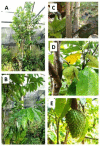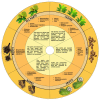Annona muricata: Comprehensive Review on the Ethnomedicinal, Phytochemistry, and Pharmacological Aspects Focusing on Antidiabetic Properties
- PMID: 36836708
- PMCID: PMC9968120
- DOI: 10.3390/life13020353
Annona muricata: Comprehensive Review on the Ethnomedicinal, Phytochemistry, and Pharmacological Aspects Focusing on Antidiabetic Properties
Abstract
Plants have played an important role over the centuries in providing products that have been used to help combat ailments and diseases. Many products originating from fresh, dried-plant materials, or extracts are utilized as community remedies in traditional practices or even in modern medicine. The Annonaceae family contains different types of bioactive chemical properties, such as alkaloids, acetogenins, flavonoids, terpenes, and essential oil, meaning the plants in this family are potential therapeutic agents. Belonging to the Annonaceae family, Annona muricata Linn. has recently attracted the attention of scientists for its medicinal value. It has been utilized as a medicinal remedy since ancient times to treat and improve various diseases, for example, diabetes mellitus, hypertension, cancer, and bacterial infections. This review, therefore, highlights the important characteristic and therapeutic effect of A. muricata along with future perspectives on its hypoglycemic effect. The most-common name is soursop, referring to its sour and sweet flavors, while in Malaysia, this tree is commonly called 'durian belanda'. Furthermore, A. muricata contains a high content of phenolic compounds in the roots and leaves. In vitro and in vivo studies have shown that A. muricata has the pharmacological effects of anti-cancer, anti-microbial, antioxidant, anti-ulcer, anti-diabetic, anti-hypertensive, and wound healing. With regard to its anti-diabetic effect, mechanisms of inhibiting glucose absorption via α-glucosidase and α-amylase activity inhibition, increasing glucose tolerance and glucose uptake by peripheral tissues, and stimulating insulin release or acting like insulin were deeply discussed. There is still a significant research gap, and future studies are required to conduct detailed investigations and gain a better molecular understanding of A. muricata's anti-diabetic potential, especially by using the metabolomics approach.
Keywords: A. muricata; Annona species; anti-diabetic effect; diabetes; metabolite changes; pharmacology.
Conflict of interest statement
The authors declare no conflict of interest.
Figures







Similar articles
-
Pharmacological Activities of Soursop (Annona muricata Lin.).Molecules. 2022 Feb 10;27(4):1201. doi: 10.3390/molecules27041201. Molecules. 2022. PMID: 35208993 Free PMC article. Review.
-
Annona muricata (Annonaceae): A Review of Its Traditional Uses, Isolated Acetogenins and Biological Activities.Int J Mol Sci. 2015 Jul 10;16(7):15625-58. doi: 10.3390/ijms160715625. Int J Mol Sci. 2015. PMID: 26184167 Free PMC article. Review.
-
Annona muricata Linn. leaf as a source of antioxidant compounds with in vitro antidiabetic and inhibitory potential against α-amylase, α-glucosidase, lipase, non-enzymatic glycation and lipid peroxidation.Biomed Pharmacother. 2018 Apr;100:83-92. doi: 10.1016/j.biopha.2018.01.172. Epub 2018 Feb 6. Biomed Pharmacother. 2018. PMID: 29425747
-
Traditional Uses, Phytochemistry and Pharmacological Activities of Annonacae.Molecules. 2022 May 27;27(11):3462. doi: 10.3390/molecules27113462. Molecules. 2022. PMID: 35684400 Free PMC article. Review.
-
Annona muricata: Is the natural therapy to most disease conditions including cancer growing in our backyard? A systematic review of its research history and future prospects.Asian Pac J Trop Med. 2017 Sep;10(9):835-848. doi: 10.1016/j.apjtm.2017.08.009. Epub 2017 Sep 13. Asian Pac J Trop Med. 2017. PMID: 29080611 Review.
Cited by
-
Nutritional and Biochemical Assessment of Edible Fruits From Angola's Native Flora.Food Sci Nutr. 2025 Jun 1;13(6):e70283. doi: 10.1002/fsn3.70283. eCollection 2025 Jun. Food Sci Nutr. 2025. PMID: 40458082 Free PMC article.
-
In Vitro Evaluation of Annona muricata Leaf Infusion as a Modulator of Antineoplastic Drug-Induced Cytotoxicity in Cancer Cell Lines.Pharmaceuticals (Basel). 2025 Aug 9;18(8):1177. doi: 10.3390/ph18081177. Pharmaceuticals (Basel). 2025. PMID: 40872568 Free PMC article.
-
Enhanced Antimalarial Efficacy of Annona muricata Leaf Extract Combined With Artesunate, Chloroquine, and Pyrimethamine in Plasmodium berghei-Infected ICR Mice.Adv Pharmacol Pharm Sci. 2025 Aug 7;2025:8736555. doi: 10.1155/adpp/8736555. eCollection 2025. Adv Pharmacol Pharm Sci. 2025. PMID: 40822987 Free PMC article.
-
Annona squamosa Fruit Extract Ameliorates Lead Acetate-Induced Testicular Injury by Modulating JAK-1/STAT-3/SOCS-1 Signaling in Male Rats.Int J Mol Sci. 2024 May 20;25(10):5562. doi: 10.3390/ijms25105562. Int J Mol Sci. 2024. PMID: 38791600 Free PMC article.
-
Induction of Bioactive Secondary Metabolites in Annona cherimola Mill. (Chirimoya) Seedlings Using Chitosan and Salicylic Acid as Elicitors.Plant Environ Interact. 2025 Aug 18;6(4):e70075. doi: 10.1002/pei3.70075. eCollection 2025 Aug. Plant Environ Interact. 2025. PMID: 40832620 Free PMC article.
References
-
- Miranda N.C., Araujo E.C.B., Justino A.B., Cariaco Y., Mota C.M., Costa-Nascimento L.A., Espindola F.S., Silva N.M. Anti-Parasitic Activity of A. muricata L. Leaf Ethanolic Extract and Its Fractions against Toxoplasma Gondii in Vitro and in Vivo. J. Ethnopharmacol. 2021;273:114019. doi: 10.1016/j.jep.2021.114019. - DOI - PubMed
Publication types
Grants and funding
LinkOut - more resources
Full Text Sources
Miscellaneous

